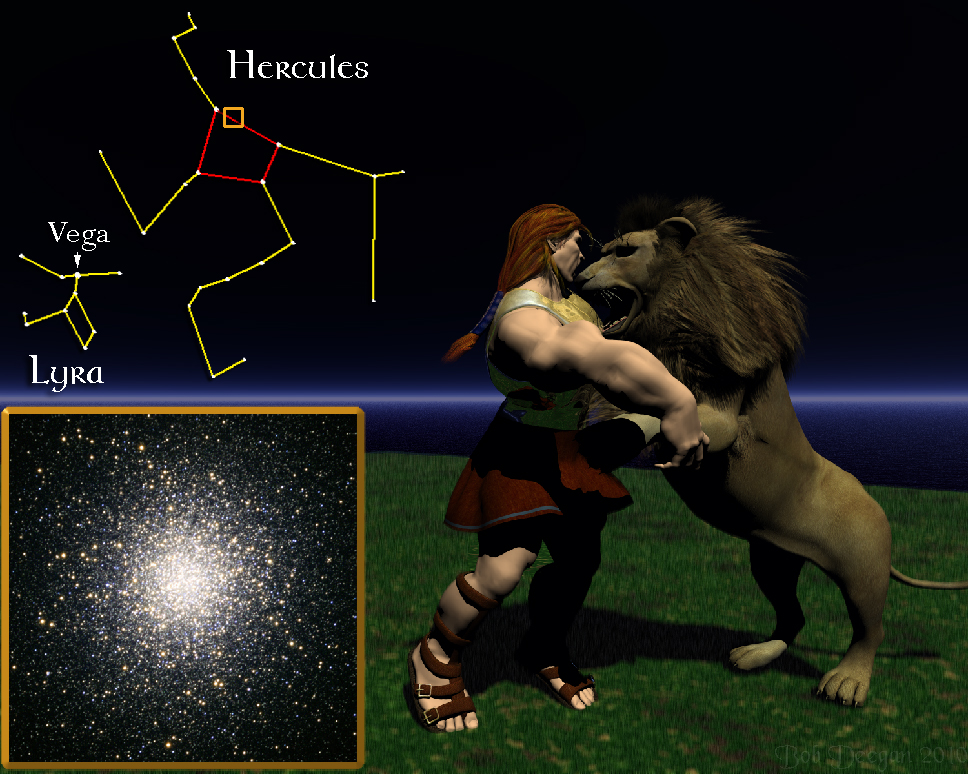
For the week including May 6, 2011

HERCULES
Hercules is one of the most prominent characters that have come to us from Greek mythology and his stories are always favorites among young readers. The most famous tales of Hercules that have found their way into the stars have to do with his Twelve Labors. During an especially low period in his life, Hercules became obligated to a hostile king named Eurystheus who challenged him to perform twelve impossible feats. The first of these labors was to kill the lion that was terrorizing the city of Nemea. A curious Hercules asked the king why the city hadn’t gotten some of its own warriors and hunters together to take care of the problem. King Eurystheus said that as man-eating lions went, this one was somewhat nastier than most. He explained that the animal was a creation of the Moon-goddess Selena and that the lion had ridden a meteor to Earth. When it settled down outside Nemea, the lion made a point of gobbling up anyone who crossed its path. Hercules was impressed by the meteor riding, but figured that a lion was just a lion after all and since he was the world’s strongest man, how much trouble could it really be? He found out when he got to Nemea. There on the outskirts of town was a great pile of broken spears, swords and arrows as well as the armor and bones of most of Nemea’s warriors. In the middle of the carnage stood the lion. Hercules wasted no time and shot it with an arrow. It simply bounced off the lion. Hercules threw a spear and it shattered on the lion’s hide. Of course, Hercules quickly understood why the lion was so formidable in combat; it was impervious to weapons! While Hercules was wondering what to do next, the lion leaped high in the air and landed on top of him. They wrestled back and forth for a night and a day. Hercules’ toughest blows had no effect on the lion and he was having a very hard time avoiding razor sharp claws and teeth. Finally, Hercules got his arms around the lion’s neck and managed to strangle it. The gods were so impressed by the epic battle that they placed the lion among the stars. Today, when the stars of Hercules appear on the horizon, the constellation of Leo, the Lion, waits for him overhead.
To find the constellation of Hercules, look toward the northeast horizon after 9pm and you will see the brilliant blue-white star named Vega in the constellation of Lyra, the Lyre. Scanning diagonally to the right of the Lyre, we come to Hercules. You can find your way to the heart of the constellation by locating another landmark called the Keystone, a group of four stars that look like the wedge-shaped central stone in an arch.
If you look closely at the Keystone on a dark, clear night you will see a faint blur of light near the end of its longest side. This blur is M13, a ball-shaped cluster of a million stars lying almost 25,000 light years away, beyond the plane of our galaxy. Visible in a telescope or binoculars and shown in the photograph at lower left, the density of M13 increases to several stars per cubic light year near its center. This volume is over 500 times more crowded than the neighborhood of our Sun. If our planet orbited a star in the region of M13, our night sky would be crammed full of thousands of stars as bright as the Moon!
M13 photo credit: Tom Bash and John Fox/Adam Block/NOAO/AURA/NSF
Unless otherwise indicated, all content of this web site is the copyright of Robert Deegan and all rights are reserved.
For more information, or to comment, please contact: Bob@NightSkies.org